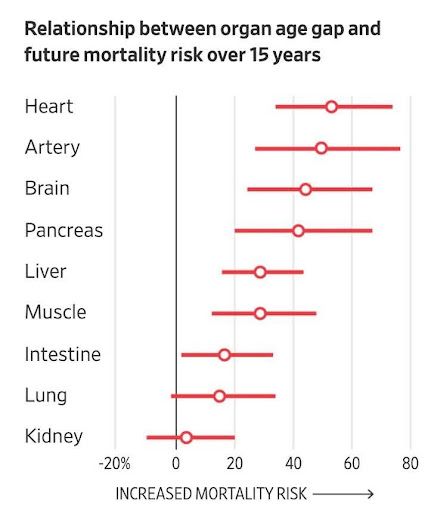Aging of Organs and Proteomics: A New Perspective
In a recent article, Dr. Éric TOPOL explores the emergence of organ protein clocks to predict and monitor aging, health, and organ-specific diseases. Three key studies are examined, highlighting how plasma proteins can reveal discrepancies between chronological age and biological age of organs, and how these discrepancies are associated with various health risks.
Aging and Proteomics
Aging is a complex process that affects each organ differently. The recent study on 'protein-based organ clocks' provides a fascinating new perspective on monitoring and predicting organ aging.
This approach uses proteomics to identify specific biomarkers associated with the aging of different organs, thus offering potentially revolutionary tools for preventive medicine and the treatment of age-related diseases.
Proteomics, the in-depth study of proteins, plays a crucial role in understanding aging. Proteins are the molecular effectors of cellular functions, and their composition, structure, and function can be altered by aging. By analyzing the protein profiles of organs, researchers can establish specific 'clocks' that reflect the aging state of these organs.
This approach allows for the early detection of organ dysfunction, well before the appearance of clinical symptoms.
Aging of Arteries and Arterial Stiffness
A striking example of the application of proteomics to organ aging is the study of arteries. With age, arteries undergo structural and functional changes, leading to increased arterial stiffness. This stiffness is a major risk factor for cardiovascular diseases and can be evaluated by measuring pulse wave velocity (PWV), a technique used by medical devices like Axelife's pOpmètre®.
Arterial Stiffness
Arterial stiffness is primarily caused by changes in extracellular matrix proteins, notably elastin and collagen. Elastin is responsible for the elasticity of arterial walls, allowing arteries to expand and contract in response to blood pressure variations. With age, elastin is gradually degraded and replaced by collagen, a stiffer protein. This substitution results in a loss of elasticity and an increase in arterial stiffness..
Role of Elastin and Collagen
- Elastin: A key protein that gives arteries their ability to stretch and retract. Its degradation, often due to enzymatic factors and oxidative modifications, reduces arterial flexibility.
- Collagen: As aging progresses, collagen production increases to compensate for the loss of elastin, but collagen is less extensible, which increases arterial stiffness..
Changes in elastin and collagen levels can be monitored through proteomic analyses, providing valuable insights into arterial health and the risk of cardiovascular diseases. For example, a disproportionate increase in collagen compared to elastin in arterial tissue samples could indicate advanced arterial aging
In a study mentioned by Dr. Eric TOPOL, involving 5 cohorts (3 healthy, 2 with Alzheimer's disease) and nearly 6,000 participants, 11 organs were evaluated with nearly 5,000 plasma proteins.

As already demonstrated in numerous studies, arterial aging is associated with an increased risk of Alzheimer's disease and dementia in general, as well as an increased risk of mortality.

Other Organs and Proteomics
As discussed in these studies, besides arteries, other organs exhibit specific proteomic signatures associated with aging. Here are a few examples:
- Brain: Changes in synaptic proteins and inflammation markers can indicate brain aging and risks of neurodegenerative diseases.
- Liver: Alterations in metabolism and detoxification proteins can signal functional decline in the liver.
- Kidneys: Modifications in filtration proteins and blood pressure regulation are indicators of kidney health.
- Muscles: Decreases in contractile proteins and metabolic enzymes reflect sarcopenia (age-related loss of muscle mass)
Protein-Based Organ Clocks Hold Huge Potential for Preventive Medicine
By identifying protein markers of aging, physicians can:
- Detect Diseases Early: Proteomic changes often precede clinical symptoms, enabling early intervention.
- Personalize Treatments: Individual proteomic profiles can guide therapeutic decisions, optimizing treatment efficacy.
- Monitor Intervention Efficacy: Changes in protein biomarkers can be used to assess the response to anti-aging treatments and health interventions.
Integrating proteomics into aging research offers promising prospects for improving health and longevity.
Understanding the mechanisms of arterial aging and the roles of elastin and collagen can particularly aid in preventing and treating cardiovascular diseases.
Devices like Axelife's Popmeter, which measure pulse wave velocity, are valuable tools for assessing arterial stiffness and monitoring cardiovascular health. By combining these technologies with advancements in proteomics, we can hope for more effective strategies to combat the effects of aging and improve patients' quality of life.
Link of the article : https://erictopol.substack.com/p/the-emergence-of-protein-organ-clocks
